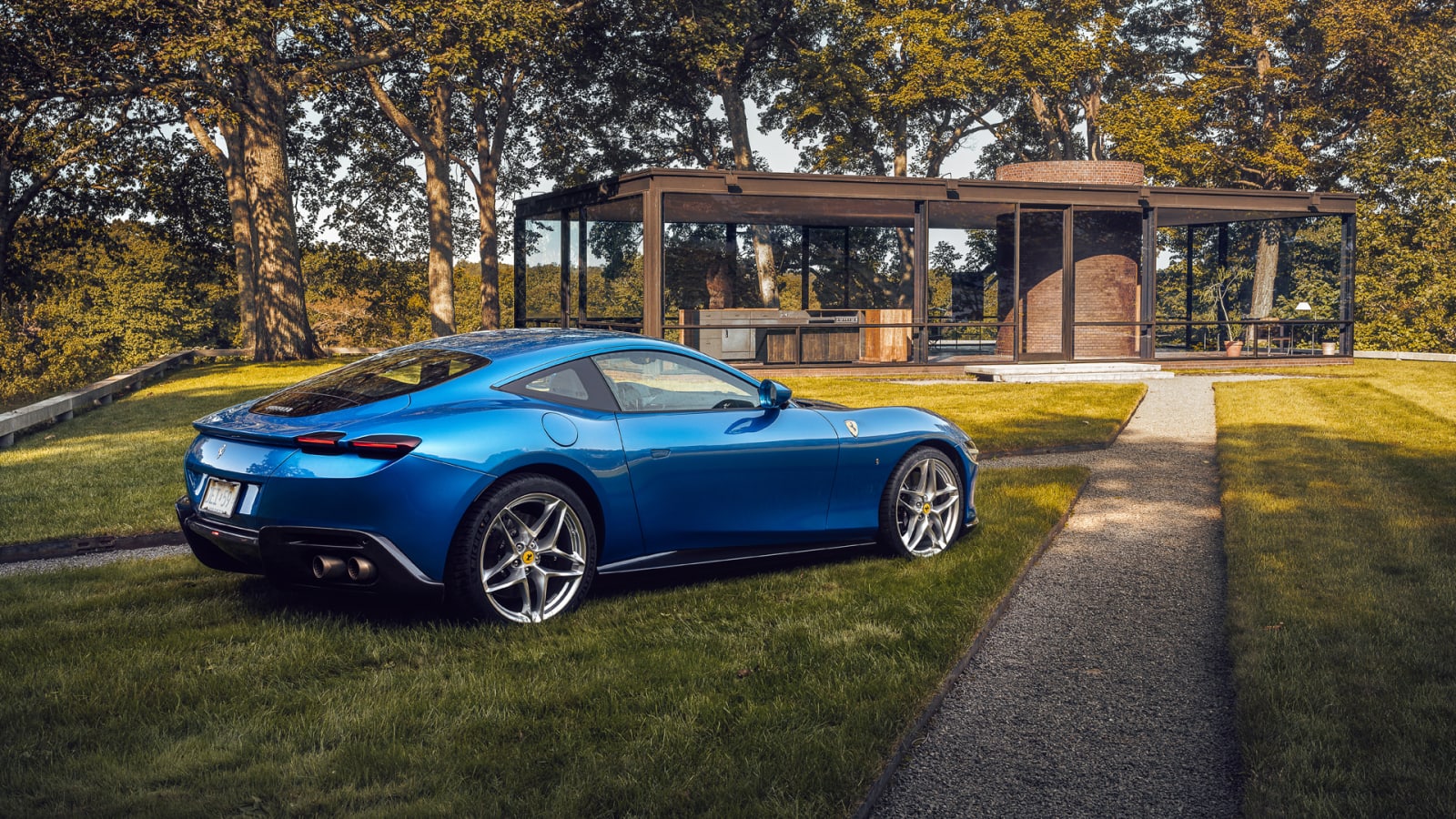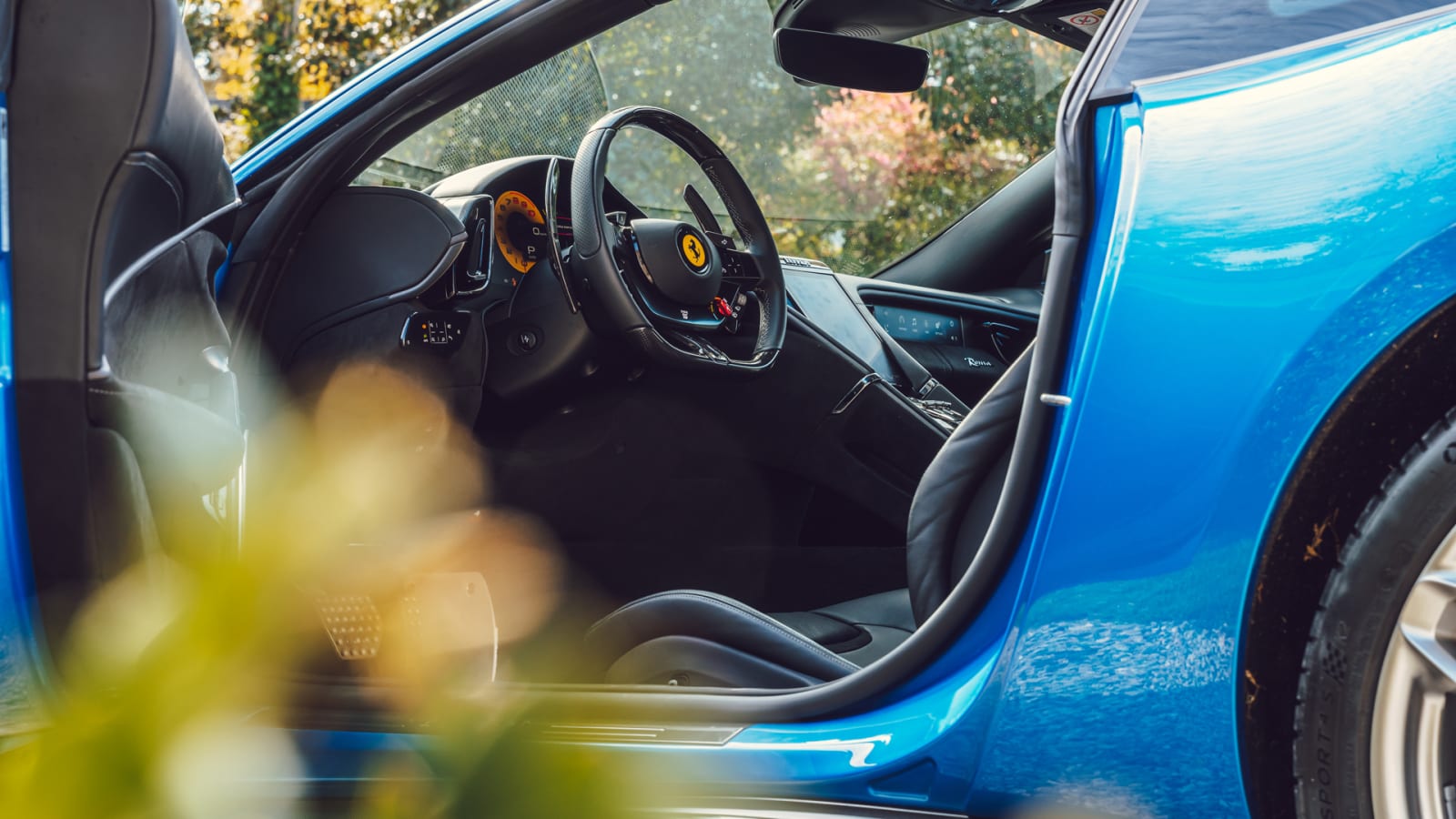I would never call the Ferrari Roma a “retro” sports car. To do so would downplay and deny the forward-looking aspect of its design and 612-horsepower performance. Yet the Roma does summon Ferrari ghosts, the ones that haunt the more-traditional branch of the family tree: The shamelessly pretty, front-engine GT’s that dominated Enzo’s dreams, before the Ferrari 308 and its mid-engine descendants — through today’s F8 Tributo and Spider — elbowed their way into the spotlight and the preponderance of sales.
That’s what made the Ferrari Roma so appealing, on a two-day tour of upstate New York and small-town Connecticut. Not every Ferrari has to shout, not when one can whisper as seductively as the Roma. With its hood out-to-here, cab at the rear, undersea snout, meringue-peaked fenders and a fuselage from a Ferrari museum (grazie, 250 GT Berlinetta), the Roma left onlookers palpitating like an Italian screen siren. It also left a trail of cars, whenever I goosed its twin-turbo, 3.9-liter V-8 — with Variable Torque Management software to balance output in any forward gear. Ferrari claims 62 mph (or 100 kph) arrives in 3.4 seconds and 124 mph in 9.3 seconds, and the car feels even quicker. The factory pegs the top speed as “above 199 mph.” Let’s call it an even 200.
Ferrari figures that for a majority of owners, the Roma will be their first-ever Ferrari. But if you dismiss this “entry-priced” Ferrari (it starts from $222,420) as some parvenu — a criticism that stuck to the first California convertible — the Roma might slap you silly. Beneath the pretty face and obliging GT personality, there’s a ferocity and focus that awaits only a driver who’s willing to unleash it.
Proof began with a fast run up the Hudson River, where the Roma’s 561 pound-feet of torque came on strong, with no trace of old-school lag. The Roma could drive happily all day in fourth gear, from 25 mph to triple digits. An afternoon shower cooled off both Roma and its pilot. Yet even without dialing up the Wet mode of the five-position manettino switch, the Ferrari’s 20-inch, Michelin Pilot Sport 4S tires hung on tight. Steering is light, yet direct and full of feel. The brake pedal had a touch too much squish for my taste, before black-painted calipers took a hard bite, but those binders are still hugely powerful.

The Roma’s combination of rigor and relaxation was thrown into relief at a tour of The Glass House in New Canaan, Conn., pictured above. Built by the late superstar architect Philip Johnson, the starkly exposed Glass House was where Johnson kept his work desk for decades, a modernist classic that seems to melt into the pastoral, 49-acre landscape. Outbuildings hold Johnson’s collection of 20th-century paintings and sculptures. Parked out front, the Ferrari’s own formal minimalism had it looking at home, and we couldn’t resist another walk-around.
My partner Paula, a former design and auto journalist, easily preferred the Roma’s understated style to that of more-swaggering, scoop-happy supercars; I suspect many women will feel the same. On that design front, some have quibbled with the Roma’s “monolithic” mesh grille: Keen to remove any superfluous adornment, Ferrari closed-off grille sections that aren’t required for cooling. Paula said the grille reminded her of an athletic cup, which certain sports-car dudes might take as a compliment. But no complaints with the LED lighting, including slim, almost miniaturized tail lamps set like gems into a concave deck.
This Roma coupe is definitely more than a gloss on a Portofino convertible, as its 70-percent-new parts count attests. The two-plus-two Roma has even more luggage space — our three good-sized bags fit in the trunk alone — and cool stuff. That includes 21 more horses (with a revised flat-plane crankshaft) a broader torque curve, and an eight-speed transmission versus the Portofino’s seven. Additional features include vortex generators up front, a deployable rear spoiler, and the latest Side Slip Control 6.0 to let experienced drivers get sideways while still laying down epic power. Kick the five-position manettino switch into Race, and the Ferrari Dynamic Enhancer hydraulically adjusts individual brake pressures to further regulate yaw angle.
That latest dual-clutch, eight-speed transmission, which debuted in the SF90 Stradale hybrid, trims 15 pounds of weight while delivering 15-percent-faster upshifts and a 21-percent edge in downshifts. It’s spectacular, challenging Porsche’s PDK for the World’s Best Automatic title, paired with the must-have option of a carbon-fiber steering wheel whose rim flashes LED alerts as the 7,500-rpm redline approaches. Gearchanges are managed through familiar rabbit-eared, carbon-fiber paddle shifters, and unfamiliar, bright-metal console sliders that nod to the gated Ferrari stick shifts of yore. Ferrari claims higher fuel efficiency as well, though that demands a shift strategy that has the car upshifting relentlessly into higher gears. The Comfort mode especially might better be called “EPA mode,” as it has the Roma stubbornly choosing seventh gear at as little as 35 or 40 mph. (Putting the Ferrari into Manual paddle-shift mode is the quickest solution.)

The flowing, wraparound cabin is striking, with sculpted rear jump seats that are great for designer luggage or shopping hauls, less great for humans beyond toddler-scale. Ferrari’s optional, right-hand Passenger Display keeps wingmen and women in the game with performance readouts, while letting them control audio and navigation functions. Paula, like most everyone who encounters the screen, got a huge kick out of it; whether that impression is worth $5,608 is up to you.
Only one thing breaks the Ferrari’s romantic spell: A human-machine interface that goes overboard with trendy capacitive, haptic-feedback controls — the kind everyone despised on various Cadillacs, Hondas, et al. That includes an engine start/stop “button” on the steering wheel that’s not really a button. Worse, the flush-mounted thingy didn’t always work on the first attempt. Personally, I’d like my six-figure Italian GT to rumble to life when I press a switch, every time. I also accidentally triggered the voice-control button switch on the steering wheel on numerous occasions.
A central, 8.3-inch screen that resembles a freestanding tablet leans into the console, capped with carbon fiber and Ferrari script. It’s operated via a steering-wheel touchpad that actually works better than, say, the awkward chiclets of Mercedes’ MBUX units. But there’s no volume knob, no analog climate or mirror controls, and no steering-wheel stalks for turn signals or wipers, the latter in keeping with every Ferrari of recent vintage. I especially missed the physical, F1-fantasy of the chunky, red-metal manettino switch, replaced with a haptic dial whose pastel readouts seem a mite precious: A video-game simulation of a Ferrari control, when we already had the real thing.

The Ferrari’s various driver-assistance systems also seem a bit nanny-ish for this type of car. When I backed into parking spaces, the Ferrari chirped at me like a bed-wetting Lexus, and for the life of me, I couldn’t get it to stop. The Roma’s configurable, 16-inch driver display has gone all-digital as well. That includes a TFT rendering of the classic, yellow central tach, complete with animated shadowing as the red pixelated needles chart their course. But I do have to say: Once the learning curve was conquered, the Ferrari’s screens and subsystems were generally easy to manipulate, more intuitive than in many cars of this stripe. And some of the digital presentations are lovely. Some may see pandering to the tech-bro, first-Ferrari crowd, including newly minted millionaires or billionaires. But Ferrari seems to be saying, “It’s the 21st century. Get used to it.”
Quibbles faded over two perfect vacation days, including a final blast to Brooklyn along my personal two-lane raceway, better known as New York’s Sawmill River Parkway. Cranked up to Race mode, the Roma ripped through gears, emitting exhaust pops and snarls on full-throttle upshifts. Traffic ahead moved right, seeing this blue flash approaching, and the Ferrari seized the advantage, performing Italian ballet at breakneck speed. If this thing is a Grand Tourer, sign me up.
Now, back to earth. Dearly priced options are unavoidable in these classes, and owners barely blink. But c’mon, Ferrari: From a quite-reasonable starting fare of $222,420, the Roma added nearly $95,000 in options to end up at $314,890. Highway robbery included roughly $10,000 for advanced driver-assistance systems that are standard or optional on cars that sell for $22,000; $8,800 for carbon fiber door sill plates; $6,075 for a surround-view camera; and Apple CarPlay that somehow costs $4,200. Fortunately, it’s not like any of this stuff is essential for a car that will assuredly end up as a weekend plaything (or worse, a garage-bound long-term investment). A buyer could definitely skip them with no second thoughts. Ditto for the roughly $32,000 in carbon-fiber add-ons, though the $11,812 rear diffuser does look sweet. Putting myself in a Ferrari buyer’s well-coiffed headspace, I’d definitely spring for the Passenger Display, Magneride dual-mode suspension ($5,568), sumptuous leather headliner ($4,219), and Scuderia Ferrari prancing-pony exterior shields ($1,856).
What the hell, let’s stitch those horses on headrests for a mere $1,266. Even in a car as elegant and understated as the Roma, a little Ferrari chest-thumping is hard to resist.
Related Video:
